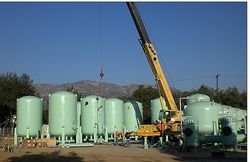Pasadena Water and Power (PWP) -- which also supplies some neighborhoods in Altadena -- and the California Dept. of Public Health (CDPH) will hold a public hearing in Altadena next week to help determine if it can bring the Monk Hill water treatment plant online, to add its water to the domestic water supply.
 The Monk Hill plant was built to clean up pollutants, particularly perchlorate and carbon tetrachloride (CTC), from four wells that were contaminated by underground plumes of water from the Jet Propulsion Laboratory. The public hearing -- part of the approval process -- will be Thurs., Feb. 24, at the Altadena Community Center, 730 E. Altadena Dr., from 7-9 PM. The public comment period, where written comments will be accepted, will be open through March 13. If approved by the PWP and CDPH, the plant could be running later in March.
The Monk Hill plant was built to clean up pollutants, particularly perchlorate and carbon tetrachloride (CTC), from four wells that were contaminated by underground plumes of water from the Jet Propulsion Laboratory. The public hearing -- part of the approval process -- will be Thurs., Feb. 24, at the Altadena Community Center, 730 E. Altadena Dr., from 7-9 PM. The public comment period, where written comments will be accepted, will be open through March 13. If approved by the PWP and CDPH, the plant could be running later in March.
Pictured: the Monk Hill Treatment System under construction. Photo courtesy NASA.
Perchlorate and its salts are used in solid propellant for rockets, missles, and fireworks. According to the CDPH, if released into the environment, perchlorate has been found to interfere with iodide uptake by the thyroid gland, which can decrease the production of thyroid hormones needed for prenatal and postnatal growth and development. It can also affect normal metabolism and mental function in adults. CTC, a volatile organic compound found in the discharge from chemical plants and industrial activities, has been linked to liver problems and cancer.
Both pollutants are regulated by the state. Perchlorate and CTC have been found in the groundwater of several sites that have been used for rocket research -- not only at JPL, but at Rocketdyne’s Santa Susana Field Laboratory in Simi Valley. At both sites, plumes of tainted groundwater have contaminated local domestic wells. In Pasadena’s case, the four wells were shut down in the 1980's and 1990's when CTC and perchlorate were detected. The CDPH classified these wells as “Extemely Impaired Sources.” Construction on the Monk Hill plant, built collaboratively by PWP and NASA, started in April, 2009.
Gary Takara, PWP principal engineer, said that the Monk Hill treatment system works like this: water from three of the wells is “boosted” to the site of the plant, where the fourth well is located. The contaminated water from all wells is run through the system, which uses a variety of means to remove the contaminants, then flows into a large pipeline, is disinfected with chlormines to make it potable, and then flows into the 4.75 million gallon Windsor Reservoir, where it is stored before entering the domestic water supply.
The Monk Hill facility is one of three treatment plants that are used to clean up pollutants from JPL. According to Merilee Fellows, NASA Manager for Environmental Communications, one of the plants is onsite at JPL, to process onsite groundwater. The other plant supplies water to Lincoln Ave. Water Co., which services northwest Altadena.
According to Lincoln Avenue Water Co. General Manager Robert Heyward, his firm's plant was constructed with NASA money, and the agency also pays for continuing operations of the plant. “Our perchlorate plant went online in 1994,” Hayward said. “It’s about a third the size of the Pasadena plant. It’s been running all this time without any major problems.”
The water is piped from Lincoln Avenue’s deep wells, decontaminated through the plant, and then sent to the distribution system. According to Hayward, about 30 percent of the water in Lincoln Ave. Water Co.’s system comes from that plant.
Hayward said that Cal EPA is the governing body over the cleanup site, which is also monitored by the state Dept. of Toxic Waste, Dept. of Water Resources, and CDPH.
PWP has several reasons for wanting to use the Monk Hill wells, primarily to keep up reliability of supply. According to a CDPH project evaluation summary (dated Feb. 11, 2011), using Monk Hill water will mean not having to rely on importing water from the Metropolitan Water District, Los Angeles City, or smaller districts such as Rubio Canyon Land and Water Assn. and Las Flores Water Co. This will also help provide a more reliable source in case of earthquakes or mandated cutbacks of MWD water.
In addition, says the summary, a consultant showed that increasing the extraction from other nearby wells is not a “viable alternative resource” because of possible contamination in these wells. In addition, the Monk Hill Treatment System (MHTS) will help contain the contaminant plume originating from JPL and keep it from migrating to other wells.
According to the summary, Battelle (the consulting firm) “compared water quality of other wells in the Raymond Basin, imported MWD water and the expected MHTS plant effluent, and concluded that the MHTS treated water will be better than or equal to the current tap water. The carbon treatment at the MHTS will remove precursors to disinfection byproducts and should result in lower concentrations of disinfection byproducts in the distribution system compared to MWD’s filtered surface water."
In an email to a customer shared with Altadenablog, PWP's Takara said that, due to distance, southeast Altadena neighborhoods served by PWP would not be serviced by water from the Monk Hill plant.
------
Some key websites for further information:
Project documents: www.PWPweb.com/MonkHill
Contact information:
Joe O’Keefe, CDPH District Engineer, 818-551-2004, jeff.okeefe@cdph.ca.gov
Gary Takara, PWP Principal Engineer, 626-744-3729 gtakara@cityofpasadena.net
City of Pasadena Monk Hill website http://ww2.cityofpasadena.net/waterandpower/monkhill/
JPL groundwater cleanup website http://jplwater.nasa.gov/NMOWeb/
JPL 2010 groundwater cleanup year in review document (English) http://jplwater.nasa.gov/NMOWeb/files/docs/home/NASA%20Cleanup%20at%20JPL%202010.pdf
(Spanish) http://jplwater.nasa.gov/NMOWeb/files/docs/espanol/cercla%20spanish%20year%20in%20review%202010.pdf
CDPH Evaluation Summary http://ww2.cityofpasadena.net/waterandpower/monkhill/CDPHMonkHillProjectEvalSummary021111l.pdf
Project documents are also available at the Altadena Main Library, 600 E. Mariposa St., and the Pasadena Central Library, 285 E. Walnut St., Pasadena.



